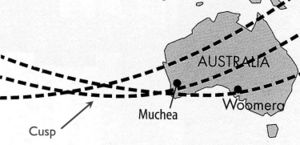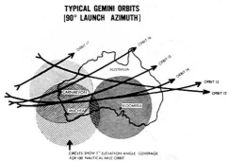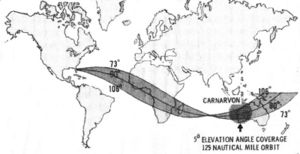Why in Western Australia?
Contents |
Choosing Muchea
Some station locations choose themselves, for example, Ascension Island in the South Atlantic Ocean – where else could you put a station? So why choose somewhere in Western Australia - at Muchea, near Perth, or at Carnarvon, 800 km to the north of Perth - when you have the rest of Australia to choose from?
The Perth region is almost diametrically opposed to the US launch site at Cape Canaveral, 195° to its west. If you could dig a hole directly through the Earth, it would come out quite near Perth. Launched at an orbit inclination of 35° a Mercury spacecraft would pass over WA on the first orbit at a critical time for confirming that a good orbit had been achieved. Perth’s latitude of 32° S placed it in the near-launch cusp of orbits where the path over the Earth’s surface changed from a southerly direction to a northerly one.
Also a location near the WA coast meant that it would be the first landfall for the spacecraft after crossing the Atlantic Ocean, ‘darkest’ Africa and the Indian Ocean – a long time without contact - particularly critical for a first Apollo pass because otherwise there would be no other support between it and Grand Canary Station over 120º to the west – a third of the Earth’s surface away.
Placing a station near a southern or a northern cusp maximizes the number of sequential orbits it can support in any one day. Cusps over land are rare in the Southern Hemisphere; just over Australia, Chile, Argentina, and South Africa, and of these only Australia was politically stable at the time.
And Carnarvon after Muchea – the two launch problem
The Gemini and Apollo missions that followed Mercury required different launch strategies. Gemini was designed to practice rendezvous manoeuvres between the astronaut capsule and a target vehicle as rehearsals for Apollo flights to the Moon. At the time, the US did not have a launch rocket large enough to launch the two Gemini spacecraft together. Each spacecraft had to be launched separately into exactly the same orbital plane because of the difficulties in changing the orbital plane after launch.
Consider the two-launch sequence. The hardest direction for a second launch would be due north over the North Pole. The first spacecraft would orbit around the Earth and back over the South Pole returning directly overhead after every sixteenth orbit, approximately twenty-four hours later. The second launch would have to be spot-on, as the launch window for a good orbit match is just a few minutes - and a launch countdown rarely goes precisely to the minute. [1] If the first opportunity were missed, the next would not occur for another twenty-four hours.
The easiest direction for both launches would be due east from the Equator. The spacecraft would then pass directly overhead at intervals of approximately ninety minutes, sixteen times a day. A narrow window would still exist to launch the second spacecraft but it would occur much more frequently - sixteen times as often.
Launches from the 28º28' N Cape Canaveral facility lay between these two extremes, but much nearer to the more manageable equatorial model. Actually, orbit inclinations ranging from 28º to 32.5º can be achieved at the Cape from launch azimuths between 73º and 106º. [2] By changing the azimuth, the launch window for the second spacecraft could be stretched to about three hours. [3] The outcome for the first orbit of such an azimuth variation could range from a pass just south of Perth to one considerably north of Port Hedland; this would be out of Muchea’s tracking range. A new tracking station further north was now vital to cover that critical first orbit and a more-northerly southern cusp.
Apollo's particular requirements
Apollo required the same solution as Gemini for a different reason. The space geometry of a manned lunar mission requires a narrow launch window of approximately two-and-a-half hours on each of three consecutive days of each lunar month to ensure that the spacecraft reached the trans-lunar injection (TLI) ‘keyhole’ at precisely the right time after a couple of Earth orbits.
It was vital to put the astronauts on the lunar surface at the optimal time: early morning during the Moon’s 327.6-hour day. To maximize each day’s window it was necessary to change the azimuth launch direction incrementally to cope with any countdown delay. This varied from an azimuth angle of 73º to 100º on the first day to an angle of 80º to 105º on the third day. [4]
The sailing strategy of an Apollo downrange tracking ship was an interesting consequence of the possible variations in launch angle; it was designed to maximize the potential length of tracking support. On Day 1, the ship would start steaming steadily south at 10 knots along the 54º W longitude from the most northerly point. It could then 'catch up' with first orbit passes that would be further and further south on each of Days 2 and 3. [5]
And now the 'Tracking & Data Relay Satellite System'
Since the 1980s virtually all ground tracking stations have become redundant for tracking Earth-orbit satellites. The advent of the Tracking and Data Relay Satellite System (TDRSS) has replaced them with more extensive support from a network of geosynchronous TDRS satellites at much less cost.
References and Notes:
1. The launch window is that short period of time in which the spacecraft must be launched
2. The azimuth is the clockwise angle between geographical north (0°) and the launch angle
3. OTDA Presentation, 7 July 1963, p.57 & Fig. 11
4. Vonbun, F.O., Ground Tracking of the Apollo, GSFC, c. 1965, p. 15
5. Vonbun, F.O., op cit., p. 12



